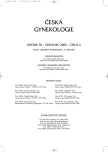-
Medical journals
- Career
Sentinel Lymphatic Node Biopsy for Breast Cancer In Practice
Authors: P. Strnad; Lukáš Rob; H. Křížová; A. Zuntová; J. Chod; M. Halaška
Authors‘ workplace: Gynekologicko-porodnická klinika, Klinika nukleární medicíny a Ústav patologické anatomie 2. LF UK a FN Motol, přednosta doc. MUDr. L. Rob, CSc.
Published in: Ceska Gynekol 2005; 70(4): 291-295
Category: Original Article
Overview
Objective:
This paper reviewed the feasibility and accuracy of sentinel lymph node status in women with breast cancer.Design:
Clinical retrospective study.Setting:
Dept. of Obstetrics and Gynecology, 2nd Medical School, Teaching Hospital Motol, Praha.Methods:
Our trial involved 169 patients with breast cancer in the T1 and T2 stage without suspicion for axillary lymph node involvement. Lymphatic mapping was performed by sub dermal or subareolar injection of 99mTc labeled collodial human albumin (Senti-Scint) in the dose of 15 MBg one day before surgery. During the operation lymphatic mapping with vital blue dye (patent blau) was performed. Then the hand-held γ-ray detector probe was used to locate the sentinel node. From a small axillary incision the blue-stained sentinel node was removed. Both methods of detection were compared, the sentinel lymph node has to be hot-radioactive and blue-stained. Complete axillary lymphadenectomy was then done. All removed lymph nodes were prepared for histopathological examination.Results:
Failures of sentinel lymph node detection were in 9 cases (5.3%) of the 169 patients. There was one case of false negative sentinel lymph node biopsy (0.6%). Most failures occurred during the learning phase of lymphatic mapping and were associated with excessive tumor involvement of axillary lymph nodes. Success of sentinel lymph node detection was in 160 cases (94.7%) and in our trial both methods of lymphatic mapping were equally effective. Tumor involvement of sentinel lymph nodes were in 43 patients (26.9%), in 19 (11.9%) of them, the sentinel nodes were the only metastasis nodes, whereas in the remaining 24 (15%) patients other axillary nodes were positive. The concordance between negative sentinel node and axillary lymph node status was in 117 (73.1%) cases.Conclusion:
The introduction of sentinel lymph node biopsy allows directed and accurate assessment of axillary involvement with minimal morbidity. Sentinel node accurately predicts the status of all axillary nodes in more than 94.7% of cases.Key words:
breast cancer, sentinel lymph node, lymphatic mapping
Labels
Paediatric gynaecology Gynaecology and obstetrics Reproduction medicine
Article was published inCzech Gynaecology

2005 Issue 4-
All articles in this issue
- Sentinel Lymphatic Node Biopsy for Breast Cancer In Practice
- The Detection of p16 Protein in Uterine Cervix Lesions
- Genetic Aspects of Malignant Epithelial Ovarian Tumours
- Prenatal Parvovirus B19 Infection in Fetus
- Pregnancy Complications after Intrauterine Hysteroscopic Surgery
- Threatening Uterine Rupture in Pregnancy after Previous Laparoscopic Myoma Enucleation. Case Report
- Influence of Serum Levels of Luteinizing Hormone during Controlled Ovarian Hyperstimulation on the Results of IVF Cycle
- Prevalence of Thrombophilia in Patients with Severe Ovarian Hyperstimulation Syndrome
- Factors Influencing Success Rate of FISH in Pre-implantation Genetic Diagnostics
- Differences in the Polychlorinated Biphenyl Levels in Follicular Fluid in Individual Types of Sterility
- Results of Transcervical Surgical Therapy on Endometrium Polyps
- Changes in Vesicalization of Urethra and Bladder after TVT Operation
- What Ultrasound Parameter is Optimal in the Examination of Position and Mobility of Urethrovesical Junction?
- TNF-α Serum Levels in Women with Endometriosis: Prospective Clinical Study
- Antibiotics prophylaxis in laparoscopy
- Czech Gynaecology
- Journal archive
- Current issue
- Online only
- About the journal
Most read in this issue- Prenatal Parvovirus B19 Infection in Fetus
- The Detection of p16 Protein in Uterine Cervix Lesions
- Changes in Vesicalization of Urethra and Bladder after TVT Operation
- Antibiotics prophylaxis in laparoscopy
Login#ADS_BOTTOM_SCRIPTS#Forgotten passwordEnter the email address that you registered with. We will send you instructions on how to set a new password.
- Career

